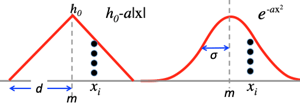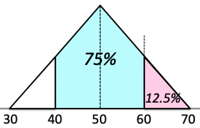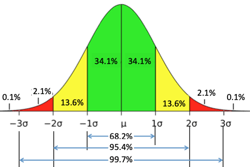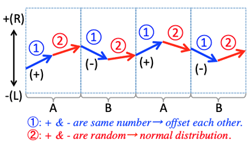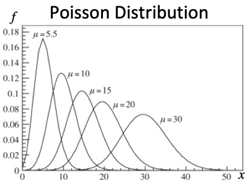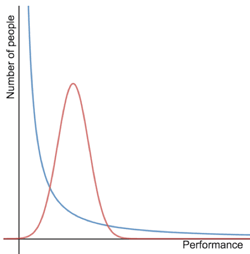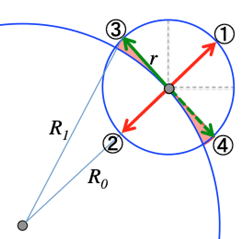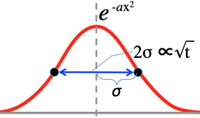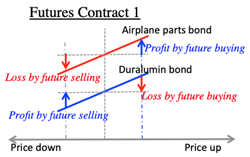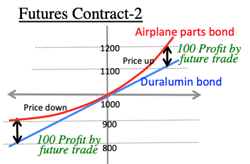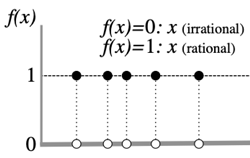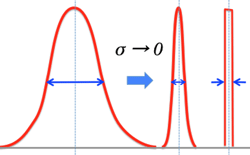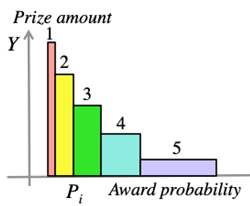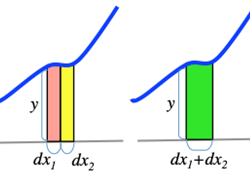>Top 6. Ito's lemma and Stochastic differential equation:
- In 1940s, Ito's lemma is an identity used in the differential equation of a time-dependent function of a stochastic process. (Stochastic differential equation)
- The lemma is widely employed in mathematical finance, particularly of Black-Scholes equation for option values.
- dx=Adt+Bdw, where Adt represents constant movement in dt, and Bdw shows random movement (B is strength of random, and Bw(t) shows displacement magnitude.)
- In applying the above equation in economics, the first term Adt shows general trend of growth to a constant direction.
- The above second term Bdw shows volatility fluctuated by global market.
- Ito's lemma indicates the clear separation of the first (=trend) and second term (=volatility).
- >Top Taylor Expansion: (useful in making approximation)
- F(x0+dx)=F(x0)+dF(x0)dxdx+12!d2F(x0)dx2dx2+13!d3F(x0)dx3dx3+…
- The second term (of dx2) has more significant function.
- Ito's lemma indicates:
- dx=Adt+Bdw;⟶dy=F(Adt+Bdw) (trying to express dy=F(dt))
- From Taylor Expansion:
dy=dFdx(Adt+Bdw)+12d2Fdx2(Adt+Bdw)2+…)
dy=dFdxAdt+dFdxBdw+12d2Fdx2(A2dt2+2ABdtdw+B2dw2)+…
- Neglection of small amount:
- Generally, dw=√dt is assumed: [random walk expands ∝√t]
- If dt=0.01;dw=0.1;dtdw=0.001;dt2=0.0001;dw2=0.01;dw3=0.001
- thus, we can leave dt,dw,dw2.
- the above equation can be simplified neglecting small terms:
dy=dFdxAdt+dFdxBdw+12d2Fdx2B2dw2
- as dw2=dt
dy=(dFdxA+12d2Fdx2B2)dt+dFdxBdw [variable separation]
- The above w is the position changing part, and dw2 cancels +dw or −dw position.]
- F(x) should be correctly F(x,t), then the above Ito's lemma equation will be:
dy=(∂F∂xA+∂F∂t+12∂2F∂x2B2)dt+∂F∂xBdw
- Significance of Ito's lemma:
- when dx=A1dt+B1dw, then if dy=A2dt+B2dw [the first term shows the world 'trend', while the second term 'volatility'.]
- from the the above equation:
- A2=dFdx・A1+12d2Fdx2・B21
- B2=dFdx・B1
- Application to non-risk portfolio:
- when the price of duralumin bond is x, the price of airplane parts is y; y=F(x)
- from Ito's lemma equation,
- dx=A1dt+B1dw, then B2dw=dFdx・B1dw
- thus, the risk of future buying of 1 unit of the airplane parts bond y can be covered by the future selling of dFdx unit of duralumin bond.
|
6.
伊藤のレンマと確率微分方程式:
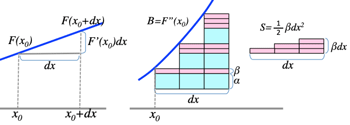
- >Top Future trade using Ito's lemma:
Case of airplane parts & duralumin:
camceling of the second term (volatility).
dFdx is called 'delta'.
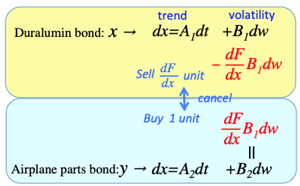
|
